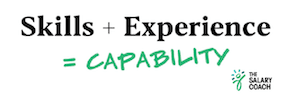We know there’s a wage gap: What can you do about it?

Where do you start in closing your pay gap? Start with these 5 steps.
I could share with you many points of information and research that debate the equal pay topic, or how the UK suspended gender pay gap reporting during the pandemic.
I can point you to what appear to be gendered decisions in the past couple of years, where women have been on the brunt of governmental decisions such as pausing breast screening in NSW and ACT.
This would do 2 things – prove I know what is going on in the market and rile you up.
I prefer to share with you what I know about how you can go about closing your own pay gap.
It isn't to say I don't believe governments and organisations have a role in this. They do and must be held to account for it.
Let's get down to it. There are a few critical steps to take to know your worth.
From the outset, I want you to know that it takes some effort to get started with this, and once you've worked through this part you're set for life. All you'll need to do from there on is maintain.
The average female salary is $60,679. How much more does the average man earn? Check out Finder's International Women's Day Report 2022.
1. Take stock
Ask yourself, "At a minimum, do I meet the performance targets set and that I have agreed to?" If the answer is yes and you can support this with evidence and discussion, you're in a great starting position.
2. Collect your data
You may need to put in a bit more time and effort at the start of this, and once you've got it together, it will become a maintenance activity. Grab any awards, accolades, thanks messages, proof of you doing a great job and develop value statements. To develop your value statements:
- Start with describing each scenario.
- Think about what transferrable skills/capabilities you built or flexed and name them.
- Write a long version of your value statement, starting with the outcome.
- Now turn it into a high-level summary.
Set a goal for having 20 of these. I know it's daunting at first to do this, yet when you get on a roll you may well surprise yourself.
I liken it to having the perfect resume – the one where you want to be able to share all of your high points and glory with the reader. You know you won't be able to, and yet having it is like always having your best friend and support person with you. No one can take that away from you. No one can tell you, "You're not worth it."
You have the evidence, and you know you're worth it! The effect of these value statements will be profound for you. It will remain with you forever, and your self-esteem and knowledge of your worth will be much stronger. It's your evidence portfolio.
3. Demonstrate your capability
When you have your examples, take a look at them and cluster the ones that are similar in terms of capability. When I say capability, what I mean is the capability equation:

Over time, you build capability. It becomes ingrained in you.
For example, when you get your license to drive you're considered competent. When you've been driving for a number of years and repeatedly experience various conditions and have learned from challenging situations you're considered capable.
Your 20+ examples will demonstrate your capability. And when you've got it in 1 place it really does make you go, "Wow, I've got this!" As you look for the themes within, you'll be starting to architect your intentional employability brand, and I'd argue, success brand. That is what you want people to be saying about you when you're not in the room.
Get your career cracking in 2022: How to build your personal brand
4. Plan your negotiation
Armed with your newly developed knowledge of your worth, start planning your negotiation. If you're negotiating in your current role, it will take a bit longer. Expect it to play out over a few months.
For a new role in the same company, it will be shorter and for a new role, in a new company faster still. Your negotiation plan is critical to your success.
Be sure to take the time and anticipate all of the hurdles and worst-case scenarios that could be presented. You'll feel good about yourself and know in your heart and mind that you're worth it. If you don't have a planner, grab a free one here.
5. Communicate – ideally in person
Communicate in a way that taps into the other person's communication mode. It is easy to speak and act your way, as it is your way and comes naturally.
Catch yourself. Take note of how the other person communicates. What words do they use? How do they hold themselves? The whole of the person. Tune in and then work out how you can best communicate with them. Add this intel to your negotiation planner to help you through the process.
A tip here: where possible, have negotiation discussions in person – that is face-to-face or via zoom. If neither is available, the phone is the next best mechanism. Your last resort will be email. You've got to be able to respond in the moment with all your senses and knowledge working with you.
How do I know this works?
Because I've used the formula all of my career. My biggest pay rise was over $100K.
It had nothing to do with gender and everything to do with how I championed for myself, how I knew my worth, how I planned the negotiation, how I communicated and my knowledge of how business budgets and frameworks work.
Our clients have so far collectively achieved nearly $41 million in salary uplift. It works! It can work for you too.
For more than 30 years, Catherine Heilemann has helped individuals and businesses identify and achieve their goals. As an expert coach, Catherine helps people to refine their focus and overcome career development blocks at The Salary Coach.
Disclaimer: The views and opinions expressed in this article (which may be subject to change without notice) are solely those of the author and do not necessarily reflect those of Finder and its employees. The information contained in this article is not intended to be and does not constitute financial advice, investment advice, trading advice or any other advice or recommendation of any sort. Neither the author nor Finder has taken into account your personal circumstances. You should seek professional advice before making any further decisions based on this information.
Read more Finder X columns
- Sending money overseas for Christmas? 5 transfer features you should look for
- Tornados and leaky toilets: 5 Aussies’ tales of Christmas chaos
- Christmas cost cutting: 14 million Aussies taking action to save on the holidays
- Bitcoin, crypto dumps – will we get a Christmas miracle or lump of coal?
- Skint for Christmas: Australians to spend $1.6 billion less on the holidays
